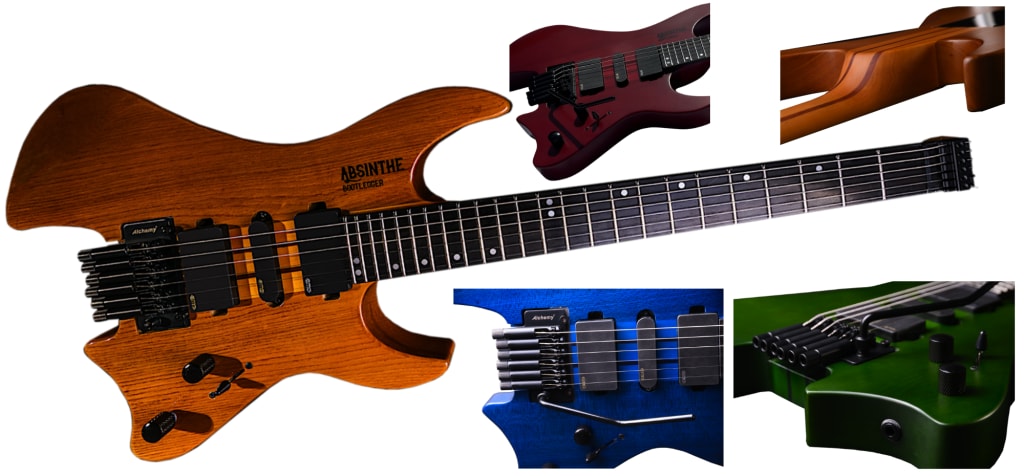Headless Guitar Evolution: Design Benefits Explored
Decoding Headless Wonders: Exploring the Evolution and Advantages of Headless Guitars

Headless guitars may seem like a new trend, but they actually have a fascinating history that dates back decades.
Brief Overview of Headless Guitar
Headless guitars, as the name suggests, are guitars that lack the traditional headstock found on most guitars. Instead of the headstock, these guitars full-length tuning mechanisms located either at the underpass or within the soul of the instrument. This design removes the weight and zillion of the headstock, resulting in a increasingly streamlined and ergonomic instrument. Headless guitars often have a modern and futuristic appearance, making them stand out in the world of guitar design.
Statement of Purpose: Exploring the Incubation and Benefits
In this blog, we embark on a journey to uncover the incubation and benefits of headless guitar design. From their unobtrusive beginnings to their current status as a popular nomination among musicians, we delve into the history and minutiae of headless guitars. Our goal is to shed light on the various advantages that headless guitars offer, from improved playability and repletion to their innovative design features. Through exploring the incubation and benefits of headless guitars, we aim to provide insight into why these instruments have wilt a staple in the music industry.
II. The Origins of Headless Guitars
A. Historical Background of Headless Guitar Design
The concept of headless guitars dates when to the mid-20th century when guitar makers began exploring volitional designs to traditional instruments. In the 1960s and 1970s, there was a surge of interest in creating guitars that were increasingly ergonomic, portable, and visually distinct. This era saw the emergence of experimental guitar designs, including the headless guitar.
B. Innovators and Pioneers in Headless Guitar Development
During this period of experimentation, several innovators and pioneers played significant roles in the minutiae of headless guitars. Ned Steinberger, founder of Steinberger Guitars, is often credited as one of the foremost innovators in headless guitar design. His groundbreaking work in the 1980s introduced the world to headless guitars with wide features such as composite materials, integrated hardware, and minimalist design.
Other notable figures in headless guitar minutiae include luthiers like Travis Bean and Gary Kramer, who experimented with unconventional materials and construction techniques to push the boundaries of guitar design. Together, these innovators and pioneers laid the foundation for the incubation of headless guitars, shaping the future of guitar design and inspiring generations of musicians and guitar makers alike.
III. Incubation of Headless Guitars
A. Transition from Traditional to Headless Designs
The transition from traditional to headless guitar designs marked a significant shift in the world of guitar craftsmanship. Traditional guitars, with their iconic headstocks, had long been the standard in the industry. However, as musicians sought instruments that were increasingly lightweight, ergonomic, and visually striking, guitar makers began exploring volitional designs.
The introduction of headless guitars represented a throw-away from tradition, offering players a sleek and modern volitional to conventional instruments. By removing the unwieldy headstock, headless guitars achieved a increasingly well-turned weight distribution and streamlined profile, enhancing repletion and playability for musicians.
B. Notable Advancements and Milestones in Headless Guitar Evolution
Over the years, headless guitars have undergone numerous advancements and milestones that have shaped their evolution. In the 1980s, companies like Steinberger Guitars introduced innovative features such as integrated tuning systems, composite materials, and ergonomic soul shapes, setting new standards for headless guitar design.
Subsequent decades saw remoter advancements in headless guitar technology, including improvements in hardware, construction techniques, and electronics. Notable milestones include the minutiae of multi-scale fretboards, zippy electronics, and MIDI integration, offering players unprecedented versatility and tenancy over their sound.
Today, headless guitars protract to evolve with advancements in materials, hardware, and design aesthetics. From shop luthiers to mass-market manufacturers, the headless guitar market is thriving with a diverse range of options to suit every style and preference. As technology and innovation protract to momentum the incubation of headless guitars, these instruments remain at the forefront of modern guitar design, pushing the boundaries of what is possible in the world of music.
IV. Benefits of Headless Guitar Design
A. Improved Wastefulness and Weight Distribution
One of the primary benefits of headless guitar design is its improved wastefulness and weight distribution. By eliminating the unwieldy headstock found on traditional guitars, headless guitars unzip a increasingly evenly distributed weight, reducing strain on the player's neck and shoulders. This improved wastefulness allows for greater self-rule of movement and enhanced repletion during long playing sessions.
B. Enhanced Playability and Comfort
In wing to improved balance, headless guitars offer enhanced playability and comfort. The sparsity of a headstock ways there's no need to reach virtually a protruding component while playing, permitting for smoother wangle to the higher frets. This streamlined design moreover reduces the overall size and weight of the instrument, making it easier to maneuver and play for extended periods without fatigue.
C. Travel-Friendly Features
Headless guitars are renowned for their travel-friendly features, making them platonic companions for musicians on the go. Their meaty size and lightweight construction make them easy to transport, whether you're heading to a gig, rehearsal, or traveling abroad. Additionally, many headless guitars full-length innovative hardware such as foldable necks or detachable components, remoter enhancing their portability and convenience.
D. Innovative Technology Integration
Another wholesomeness of headless guitar design is its potential for innovative technology integration. With advancements in electronics and hardware, headless guitars can incorporate cutting-edge features such as seated effects, MIDI connectivity, and wireless technology. These integrated technologies unshut up a world of possibilities for creative expression and sonic experimentation, permitting players to explore new sounds and textures with ease.
E. Stimulating Request and Modernization
Finally, headless guitars offer stimulating request and modernization to players seeking instruments that reflect their style and personality. With their sleek and futuristic appearance, headless guitars stand out from traditional designs, making a unvigilant statement on stage or in the studio. Whether crafted from exotic woods, high-tech materials, or custom finishes, headless guitars exude a sense of modernity and sophistication that resonates with today's discerning musicians.
V. Case Studies: Headless Guitars in Action
A. Profiles of Musicians and Bands Using Headless Guitars
To showcase the versatility and request of headless guitars, let's explore profiles of musicians and bands who have embraced these innovative instruments in their music.
Tosin Abasi (Animals as Leaders): Renowned for his virtuosic playing and innovative techniques, Tosin Abasi is a prominent well-wisher of headless guitars. His signature models full-length extended-range fretboards and ergonomic designs, permitting him to push the boundaries of progressive metal and fusion.
Mark Holcomb (Periphery): As the lead guitarist for progressive metal wreath Periphery, Mark Holcomb relies on the modern features and versatility of headless guitars to unhook his dynamic and expressive playing style. His custom models are equipped with high-output pickups and wide electronics for maximum tonal flexibility.
Yvette Young (Covet): Yvette Young, the guitarist and vocalist of math waddle wreath Covet, showcases the melodic and intricate possibilities of headless guitars. Her custom instruments full-length multi-scale fretboards and innovative hardware, enabling her to craft ethereal soundscapes and ramified arrangements with ease.
VI. Future Trends and Possibilities
A. Predictions for the Future of Headless Guitar
As technology and craftsmanship protract to advance, the future of headless guitar holds heady possibilities. Here are some predictions for what we might see in the coming years:
Further Refinement of Ergonomic Designs: Expect to see unfurled efforts to enhance the ergonomic features of headless guitars, with a focus on improving repletion and playability for musicians of all skill levels.
Integration of Smart Technology: With the rise of smart devices and connectivity, future headless guitars may incorporate innovative technology such as seated effects, wireless connectivity, and digital modeling capabilities, offering players unprecedented tenancy over their sound.
Exploration of Sustainable Materials: As environmental concerns wilt increasingly important, guitar makers may explore the use of sustainable materials and eco-friendly manufacturing processes in the production of headless guitars, contributing to a increasingly sustainable future for the industry.
B. Potential Innovations and Developments on the Horizon
Looking ahead, here are some potential innovations and developments that could shape the future of headless guitar design:
Advancements in Lightweight Materials: The minutiae of new lightweight materials and construction techniques could remoter reduce the weight of headless guitars without compromising on tautness or tone, making them plane increasingly well-appointed and portable for musicians on the go.
Enhanced Customization Options: With the growing demand for personalized instruments, future headless guitars may offer expanded customization options, permitting players to tailor their instruments to their unique preferences and playing styles.
Integration of Strained Intelligence: The integration of strained intelligence (AI) technology could revolutionize headless guitar design, with AI algorithms profitable in the optimization of tone, playability, and performance based on user input and feedback.
As we squint towards the future, the possibilities for headless guitar design are limitless, driven by a combination of technological innovation, originative creativity, and the evolving needs and preferences of musicians virtually the world.
VII. Conclusion
As we reflect on the significance of headless guitars in the music industry, it becomes well-spoken that these instruments represent increasingly than just a throw-away from tradition—they symbolize innovation, progress, and the spirit of exploration in music. By challenging conventional wisdom and embracing new approaches to guitar design, headless guitars have opened up new possibilities for musicians to express themselves and push the boundaries of creativity.
Whether you're a seasoned professional or an aspiring musician, the voodoo of headless guitars lies in their worthiness to inspire, innovate, and hoist the art of music-making to new heights. As we squint to the future, the legacy of headless guitars will protract to resonate, shaping the way we perceive, create, and wits music for generations to come.
About the Creator
Patricia
I am a writer, blogger and nature lover. I love to write on different topics.
Enjoyed the story? Support the Creator.
Subscribe for free to receive all their stories in your feed. You could also pledge your support or give them a one-off tip, letting them know you appreciate their work.






Comments
Patricia is not accepting comments at the moment
Want to show your support? Send them a one-off tip.